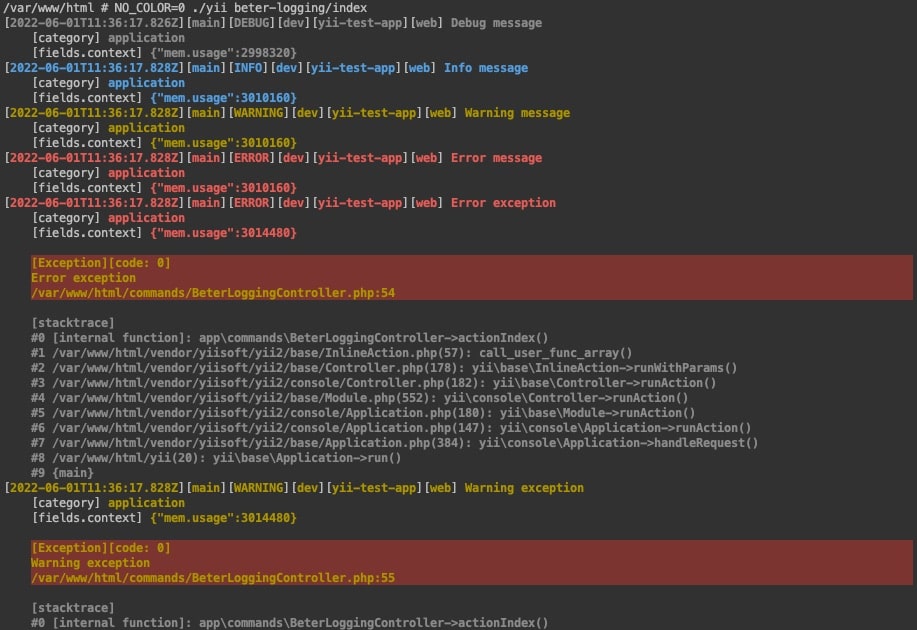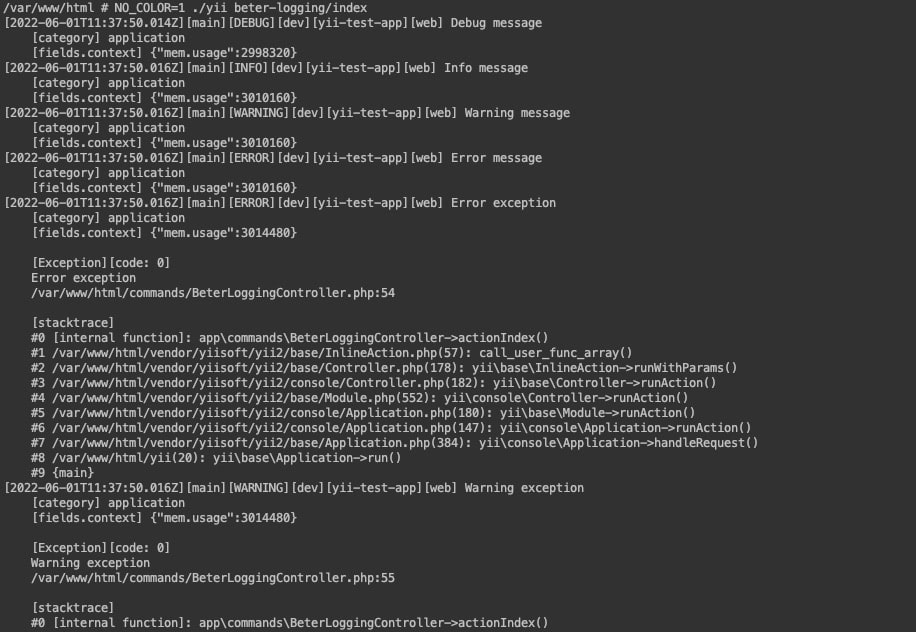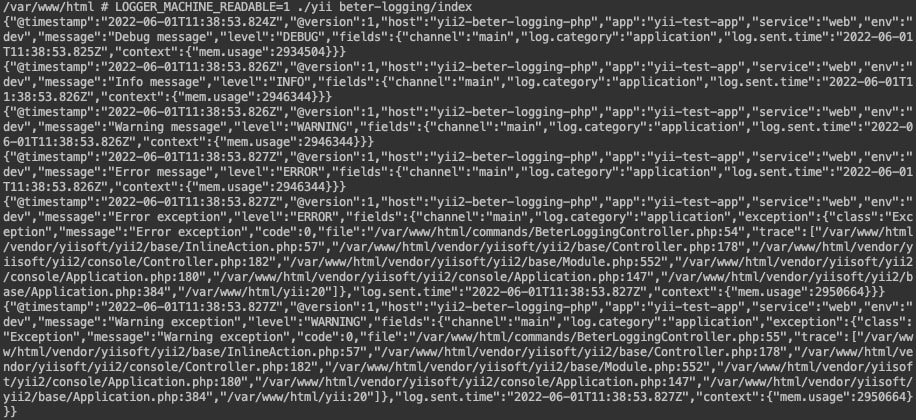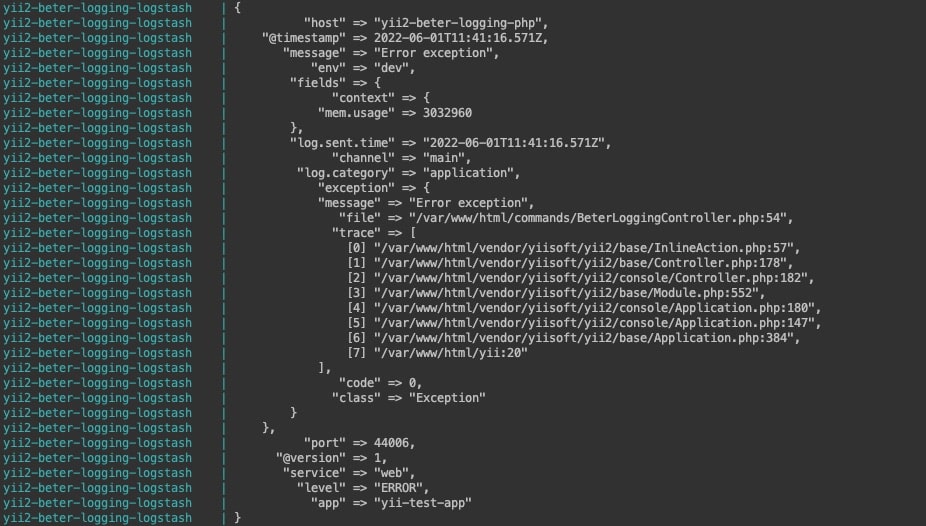Many modern applications ship web services, cronjobs and workers.
Each of them requires its own logging pipeline and can't be used with default settings. Imagine you need to have
- script for manual launch, like database migration script;
- script to make some cleaning (cronjob script)
The difference between them consists in the fact that you are obliged to have different settings. Definitely you don't need to send logs to logstash when you run manual migration, because you want to see pretty printed errors in your console. From the other hand, you don't want to read log files of cronjobs, I believe you want to use logstash for that type of jobs. Even if you are a fan of "12-factor app", and you want to deliver log entries in the JSON format, you need different setup.
Sometimes it can be solved by creation of few environments and separation of application. Part of described issues will follow you anyway.
But yii2-beter-logging makes your life easier and solve described issues.
To implement yii2-beter-logging approach just use Beter\Yii2\Logging\EnvVarSettings class. This class contains
a set of helpers that checks variables in the $_SERVER and checks variables set up as an environment variables.
$_SERVERsuper globals may contain variables passed by nginx, apache or any other webserver. As an example, for php-fpm they are set withphp_flag,php_admin_flag,php_value,php_admin_value. Check the doc.
Here is a sample script that demonstrates this approach for a specific script
<?php
use Beter\Yii2\Logging\EnvVarSettings;
$useColors = EnvVarSettings::colorSettingEnabled() ?? true;
$machineReadableFormat = EnvVarSettings::machineReadableSettingEnabled() ?? false;
$logstashEnabled = EnvVarSettings::logstashSettingEnabled() ?? false;EnvVarSettings::colorSettingEnabled()checksNO_COLORenv setting;EnvVarSettings::machineReadableSettingEnabled()checksLOGGER_MACHINE_READABLEenv setting;EnvVarSettings::logstashSettingEnabled()checksLOGGER_ENABLE_LOGSTASHenv setting;
EnvVarSettings::colorSettingEnabled() follows https://no-color.org/ approach and can't be redefined.
All other methods may be called with a parameter that specifies env name to check, for example,
EnvVarSettings::logstashSettingEnabled('LOGSTASH') will check $_SERVER['LOGSTASH'] and will call
getenv('LOGSTASH').
Every method returns:
trueif env setting is one of the stringsTrue,true,Trueor1.falseif env setting is one of the stringsFalse,false,Falseor0.nullfor other scenarios or if no env setting was detected at all.
$ php script.php // EnvVarSettings::colorSettingEnabled() === null
$ NO_COLOR=1 php script.php // EnvVarSettings::colorSettingEnabled() === true
$ NO_COLOR=True php script.php // EnvVarSettings::colorSettingEnabled() === true
$ NO_COLOR=0 php script.php // EnvVarSettings::colorSettingEnabled() === false
$ NO_COLOR=anythingelse php script.php // EnvVarSettings::colorSettingEnabled() === null
$ NO_COLOR= php script.php // EnvVarSettings::colorSettingEnabled() === null
$ LOGGER_ENABLE_LOGSTASH=1 php scrip.php // EnvVarSettings::logstashSettingEnabled() === true
$ LOGSTASH=1 php scrip.php // EnvVarSettings::logstashSettingEnabled() === false
$ LOGSTASH=1 php scrip.php // EnvVarSettings::logstashSettingEnabled('LOGSTASH') === falseIt's possible to play with examples in a demo container.
Colorized stderr output
NO_COLOR=1 or colorize == false in the console formatter.
LOGGER_MACHINE_READABLE=1 or logstash formatter for the standard_stream handler.
Structure for the message for the logstash is parsed by the logstash successfully.
Structure for the extension for the logstash parsed by the logstash successfully.
You may use these methods to implement logic in your config files. Here is an example for console.php yii config.
<?php
use Beter\Yii2\Logging\MonologComponent;
use Beter\Yii2\Logging\ProxyLogTarget;
use Beter\Yii2\Logging\EnvVarSettings;
$params = require __DIR__ . '/params.php';
$db = require __DIR__ . '/db.php';
$useColors = EnvVarSettings::colorSettingEnabled() ?? true;
$machineReadableFormat = EnvVarSettings::machineReadableSettingEnabled() ?? false;
if ($machineReadableFormat) {
$standardStreamFormatter = [
'name' => 'logstash',
'trace_depth' => 10,
];
} else {
$standardStreamFormatter = [
'name' => 'console',
'colorize' => $useColors,
'indentSize' => 4,
'trace_depth' => 10,
];
}
$config = [
'id' => 'basic-console',
'basePath' => dirname(__DIR__),
'bootstrap' => ['monolog', 'log'],
'controllerNamespace' => 'app\commands',
'aliases' => [
'@bower' => '@vendor/bower-asset',
'@npm' => '@vendor/npm-asset',
'@tests' => '@app/tests',
],
'components' => [
'cache' => [
'class' => 'yii\caching\FileCache',
],
'monolog' => [
'class' => Beter\Yii2\Logging\MonologComponent::class,
'channels' => [
'main' => [
'handler' => [
[
'name' => 'standard_stream',
'stream' => 'php://stderr',
'level' => 'debug',
'bubble' => true,
'formatter' => $standardStreamFormatter,
],
],
'processor' => [
[
'name' => 'basic_processor',
'env' => YII_ENV, // dev, prod, etc
'app' => 'myapp',
'service' => 'myservice',
'exec_type' => 'cli', // or web, or sapi name
'host' => gethostname(), // or set it as you want
]
],
],
],
],
'log' => [
'targets' => [
[
'class' => 'yii\log\FileTarget',
'levels' => ['error', 'warning'],
],
],
],
'db' => $db,
],
'params' => $params,
];
$logstashEnabled = EnvVarSettings::logstashSettingEnabled() ?? false;
if ($logstashEnabled) {
$logstashHandlerConfig = [
'name' => 'logstash',
'label' => 'logstash',
'level' => 'debug',
'bubble' => true,
'host' => '1.2.3.4', // or host.address.com
'port' => 5044,
'socket_transport' => 'tcp',
'persistent' => false,
'socket_timeout' => 1,
'writing_timeout' => 1,
'connection_timeout' => 1,
'max_handle_errors_before_disabling' => 3,
'formatter' => [
'name' => 'logstash',
'trace_depth' => 10,
]
];
// add as a first handler, bubbling
array_unshift($config['components']['monolog']['channels']['main']['handler'], $logstashHandlerConfig);
}
return $config;



